Well, pevenson, at least I could understand your question and I want to tell you about non-leather footwear in Spain.
In Spain, there are several types of non-leather footwear.But, I think that the most famous is the “Alpargata” (Espadrille). The espadrille is a type of footwear, spinning natural fibers such as hair, cotton, animal skins or canvas, soled esparto, sisal or hemp, which is secured by a simple adjustment or ribbons.

Esparto soled
The espadrille is used mainly in Spain, southern France and parts of Latin America.
It is believed that the espadrille was originated in Egyptian sandal, which then the Romans were inspired to develop a covered slipper and to protect the foot from the sun and heat. Are documented In Europe, they are documented since at least the year 1322, when a document written in Catalan describes espardenyes 'espadrilles' and mentions its current name in Catalan. In Catalan "slipper" is also called espardenya.
Same as, they were used in America, before the European contact. In America, the earliest record of espadrille is a part of a collection of articles from the Chaco region (Argentina), in the twelfth century.
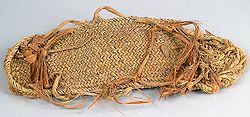
Espadrille from Chaco (a region of Argentina) in the twelfth century
Both Uruguay and Argentina, it is adopted by rural workers to replace the boot rack. Unlike other garments , the humble espadrille became a ubiquitous garment for both sexes but especially in the inseparable companion of her baggy trousers. Useful for those who could well serve long journeys comfortable footwear, since it was used as an ally of days under the summer rain by peasants and accompanied the rhythmic tread of the popular dance. Has currently been for cultural , clothing garments laborers or profane acts, the espadrille has become cheap shoes and everyday of the gauchos and countrymen ; although it is common to use this comfortable and lightweight footwear by most of the population, when they are on vacation, in warm areas. Espadrilles entered the Argentine political scene in the run-up to presidential term of Juan Domingo Peron, when they were tied with the working class. In 1943 and 1944, the student movement opposed Perón and labor unions, that supported his actions , began using the slogan "no to the dictatorship of the sandals”, which was in turn responded with the slogan "yes espadrilles, not books". In the first half of the twentieth century, it was so common to use sandals among the lower classes of the population, that it became very importance the company called “Factory Alpargatas Argentina”, which is used to promote art, with wall calendars illustrated by Florencio Molina Campos.
Specifically in Spain, it was particularly widespread use in the territories of the former Crown of Aragon (Aragon, Catalonia, Valencia and the Balearic Islands) and the Castilian origin as in Murcia, Almería, Granada and the Basque cultural field (Basque Country, Navarra and the French Basque Country). It is also traditional in Occitania (southern French Country), having its major production center in Mauleon, capital of the Basque-speaking region of France Sola. In Spain, it was also extended as urban worker footwear or even footwear for soldiers, and today it is commonly used as a casual garment in the hottest months, just as in Mexico, other Caribbean countries and in the United States.
In Uruguay and Chile are commonly used in summer to go to the beach or for any outdoor activity. As a fresh footwear, foot stops breathing and it is adapted to the shape of it, being comfortable for various activities.
In Colombia, it is part of the clothing of most costumes, being, in some cases, of sisal or other cocuiza and leather. The inhabitants of the Orinoco River basin, also produce them of animal skin and call them "cotizas" or Cocuizas.
The espadrille is equally used by men and women, although some varieties may have fabric edges and shapes, as well as a "little poppy" in the fabric, contrasting color, to differentiate them from those of universal use. Traditionalists argue that this detail is for the Wayuu indigenous culture of the La Guajira Peninsula, but is alien to dancing tamunangue in Lara, Venezuela, where footwear is typical of women's attire State.
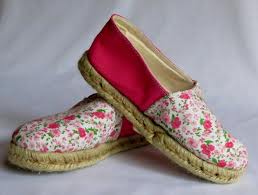
.jpg)
A similar flower than poppy Espadrille with several flowers
In Venezuela it is a very lightweight and comfortable footwear, very appropriate for the tropical climate, used mostly by peasants, but the espadrille is also used in the region of the Venezuelan plains and in many rural areas of the country.
Espadrilles are manufactured using a strong canvas, soled jute or hemp rope. Espadrilles are very light, with good grip on the floor and very thin. Currently its fabric has been industrialized and nylon yarns and rubber sole are used, as well as tarp covers and base cocuiza or other vegetable fiber. The espadrille is woven by hand on looms using triangular homemade wick (“pabilo”) (cotton yarn), combining different colors. The sole can be of leather or cocuiza. It consists of the uppers or Capellá (top that covers the instep and forefoot), "heel" (Talonera) (part forming the arch of the heel) and the "abattoir" (atadero) (also called "Correita”, which serves to hold the uppers to the heel).
This is the most common alpargata (espadrille) and which I love:
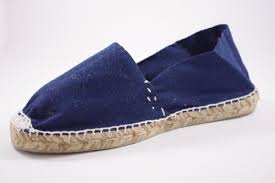
Espadrille with colour dark blue. This is which I buy every year.
Moreover, this (the dark blue colour is my favorite, every summer.
But, you can buy espadrilles of another colours, for men and for women –-they are the same models--:
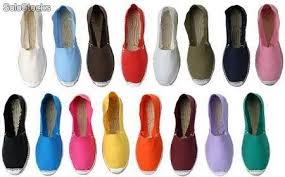
Espadrilles of many colours
But, also exists another model of espadrille, a Little bit different, because this one is stronger, thicker and….a little bit more expensive, logically:
.jpg)
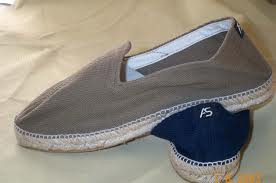
A turquoise espadrille Brown and dark blue espadrilles
There are a variety of types of espadrilles, mainly divided into two classes: those which conform with ribbons and no.
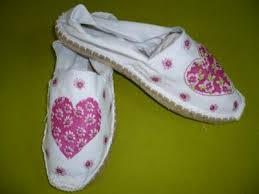
Espadrille with another design
This is the espadrille that I use to buy for my wife –-in black, white and beige colours--:
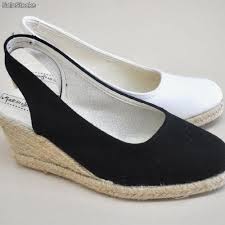
My wife´s favorite espadrille
But sometine I bought this type of espadrille:
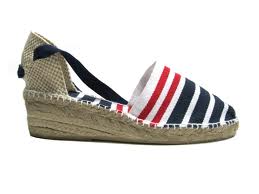
Another confortable espadrille, for my wife
Another types of espadrilles with ribbons:
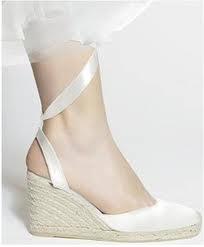
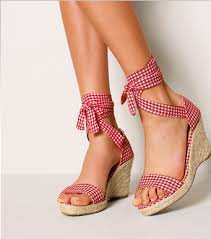
An elegant model of espadrille Another nice model
You can also split between flat, like traditional, and high heel, which typically incorporate a wedge.
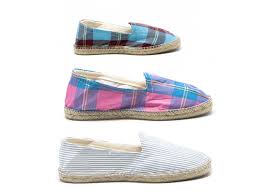
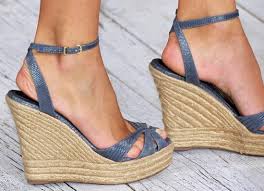
Flat espadrilles Espadrilles with wedge
For example, my wife does not like this type of wedge.
it is now common for soled is wholly or partially covered with a thin layer of rubber to protect from moisture and wear.
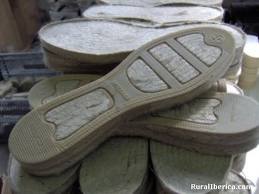
Soles with rubber
But, morevover of espadrilles, there is another type of footwear, made of canvas and rubber. And there are several colours, used above all by young people –boys and girls, from 17 to 25 years old--:
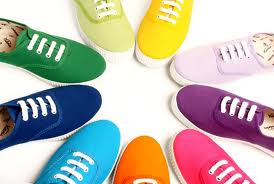
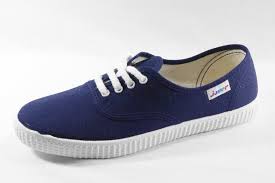
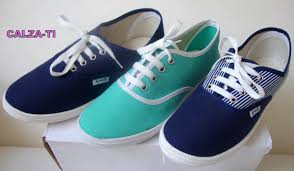
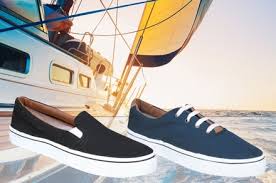
Well, pevenson, I hope I have satisfied your curiosity about non-leather footwear.
If you have another question, I will be happy to clarify it for you.
Till soon, kind regards,
Luis.
Sponsored by Costaluz Lawyers.
Please click down here:
